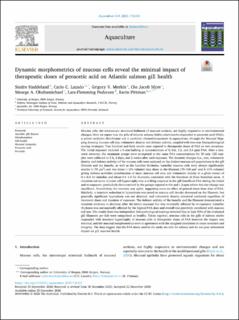| dc.description.abstract | Mucous cells, the microscopic structural hallmark of mucosal surfaces, are highly responsive to environmental changes. Here we report how the gills of Atlantic salmon (Salmo salar) responded to peracetic acid (PAA), a potent oxidative disinfectant and a candidate chemotherapeutant in aquaculture, through the mucosal mapping showing mucous cell size, volumetric density and defence activity, coupled with two-way histopathological scoring strategies. Two hundred and forty smolts were exposed to therapeutic doses of PAA on two occasions. The initial exposure included a 5-min bathing at concentrations of 0, 0.6, 1.2, and 2.4 ppm PAA. After a two-week recovery, the treatment groups were re-exposed to the same PAA concentrations for 30 min. Gill samples were collected at 2 hours, 2 days, and 2 weeks after each exposure. The dynamic changes (i.e., size, volumetric density and defence activity) of the mucous cells were analysed on the distinct mucous cell populations in the gill filament and the lamella, as well as the lamellar thickness. Lamellar mucous cells were always significantly smaller (<70 µm2) and less dense (<2% volume) than those in the filament (70-100 µm2 and 8-11% volume) giving defense activities of 0.1-0.4 for lamellae and about 0.6 – 1.4 for filaments, consistent with the functions of these branchial areas. A transient sub-acute mucous cell hypertrophy was a striking response in the gill lamella to PAA during the initial and re-exposure, particularly demonstrated by the groups exposed to 0.6 and 1.2 ppm where this size change was significant. Nonetheless, the recovery was quick, suggesting more an effect of general stress than dose of PAA. Similarly, a transient reduction in hyperplasia was noted as mucous cell density decreased on the filament, but generally significant hyperplasia was not detected, and volumetric density remained unaltered regardless of treatment doses and duration of exposure. The defence activity (combination of mean mucous cell area and volumetric density in a given tissue) of the lamella and the filament demonstrated a transient tendency to decrease after the initial exposure but was minimally affected by re-exposure. Lamellar thickness was not markedly affected by the highest PAA dose and overall was positively correlated with mucous cell size. The results from two independent histopathological scorings revealed that at least 93% of the evaluated gill filaments per fish were categorised as healthy. Taken together, mucous cells in the gills of salmon responded with transient hypertrophy of mucous cells to therapeutic doses of PAA however the impact was minimal, and the mucosal morphometrics were in agreement with the marginal alterations in tissue structure and integrity. The data suggest that the PAA doses used in the study are safe for salmon and do not pose substantial impact on gill mucosal health. | en_US |

